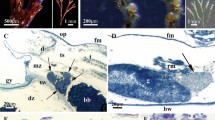Abstract
Bivalve molluscs can bioaccumulate, in their tissues, well known viruses that infect humans and higher animals. However, since 1969 there have been reports, based largely on ultrastructural studies, that have indicated there are also viruses which infect these molluscs. Lack of bivalve molluscan cell lines has limited the isolation of these viruses, although some viruses isolated in fish cell lines are claimed to be infective for bivalves. Distinctive morphogenesis and characteristics of iridoviruses have been reported in larval and adult oysters in association with infections of epithelial and haemocytic tissues. Herpes viruses have been reported in the American oyster, Pacific oyster, and European flat oyster from three continents. The herpes viral agent in Pacific oysters has been experimentally transmitted and requires temperatures of 25–26°C for a productive infection and clinical disease. Papova-like viruses, picorna-like, and other small virus-like particles have been reported in several bivalve species. A leukemia-like disease of many bivalve species, collectively termed disseminated neoplasias, is of unconfirmed aetiology, but may be related to retroviral infections. Representatives of the Reoviridae and Birnaviridae have been isolated by using fish cell lines. One definitive study concludes that at least one example is not infective for bivalves while other studies claim molluscan infectivity. Phages have been reported in three pathogenic agents infecting bivalves. Advancement in the field of molluscan virology will require increased application of physical isolation methods, refinement of primary cell culture methods, use of molecular diagnostic tools, and the development of continuous molluscan cell lines.
Similar content being viewed by others
References
Appeldoorn, R.S., Brown, C.W., Brown, R.S., Chang, P.W., Cooper, K.R., Lorda, E., Saila, S., Walker, H. & Wolke, R.E. 1984 Field and laboratory studies to define the occurrence of neoplasia in the soft-shell clam, Mya arenaria. American Petroleum Institute Publication 4345. Washington, DC: American Petroleum Institute.
Azevedo, C. 1990 Virus-like particles in Perkinsus atlanticus (Apicomplexa, Perkinsidae). Diseases of Aquatic Organisms 9, 63-65.
Brewster, F. & Nicholson, B.L. 1979 In vitro maintenance of amoebocytes from the American oyster (Crassostrea virginica). Journal of the Fisheries Research Board of Canada 36, 461-467.
Buchanan, J.S. 1978 Cytological studies on a new species of rickettsia found in association with a phage in the digestive gland of the marine bivalve mollusc, Tellina tenuis (da Costa). Journal of Fish Diseases 1, 27-43.
Chou, H.Y., Li H.J. & Lo, C.F. 1994 Pathogenicity of a birnavirus to hard clam (Meretrix lusoria) and effect of temperature stress on its virulence. Fish Pathology 29, 171-175.
Comps, M. 1970 La maladie des branchies chez les huîtres du genre Crassostrea, caractéristiques et évolutions des altérations, precessus de cicatrisation. Revue des Travaux de l'Institut des Pêches Maritimes 34(1), 23-44.
Comps, M. 1980 Mise en évidence par fluorescence du virus de la maladie des branchies de l'huître portugaise Crassostrea angulata Lmk. Science et Pêche, Bulletin de l'Institut des Pêches maritime 301, 17-18.
Comps, M. 1988 Epizootic disease of oysters associated with viral infections. In Disease Processes in Marine Bivalve Molluscs, ed Fisher, W.S. pp. 23-37. Bethesda, Maryland: American Fisheries Society Special Publication 18.
Comps, M. & Bonami, J.R. 1977 Infection virale associée à des mortalités chex l'huître Crassostrea gigas Th. Comptes Rendus Hebdomadaire des séances de l'Academie des Sciences, Série D, Sciences Naturelles 285, 1139-1140.
Comps, M. & Cochennec, N. 1993 A herpes-like virus from the European oyster Ostrea edulis L. Journal of Invertebrate Pathology 62(2), 201-203.
Comps, M. & Duthoit, J.L. 1976 Infection virale associée à la `maladie de branchies' de l'Huître portugaise Crassostrea angulata Lmk. Comptes Rendus Hebdomadaire des séances de l'Academie des Sciences, Série D, Sciences Naturelles 283, 1595-1597.




